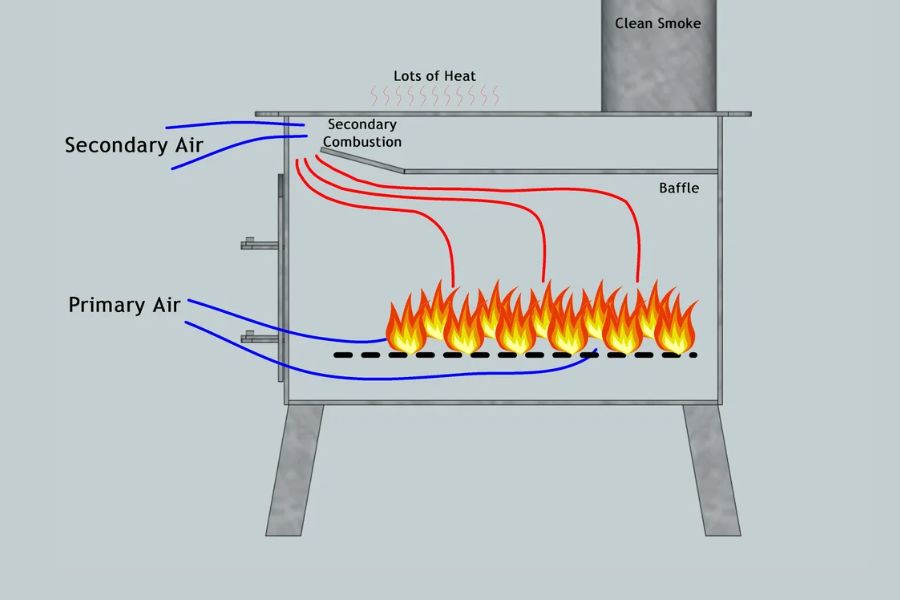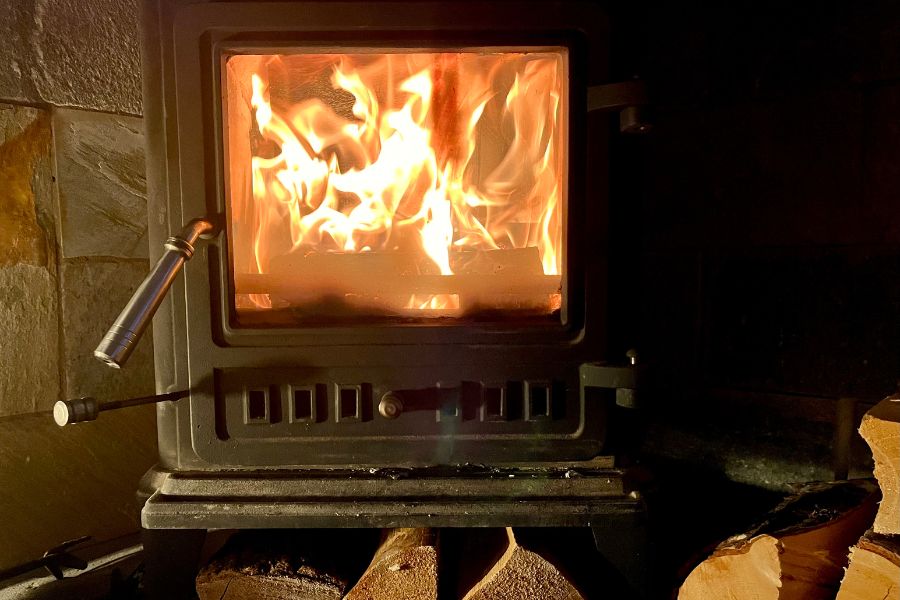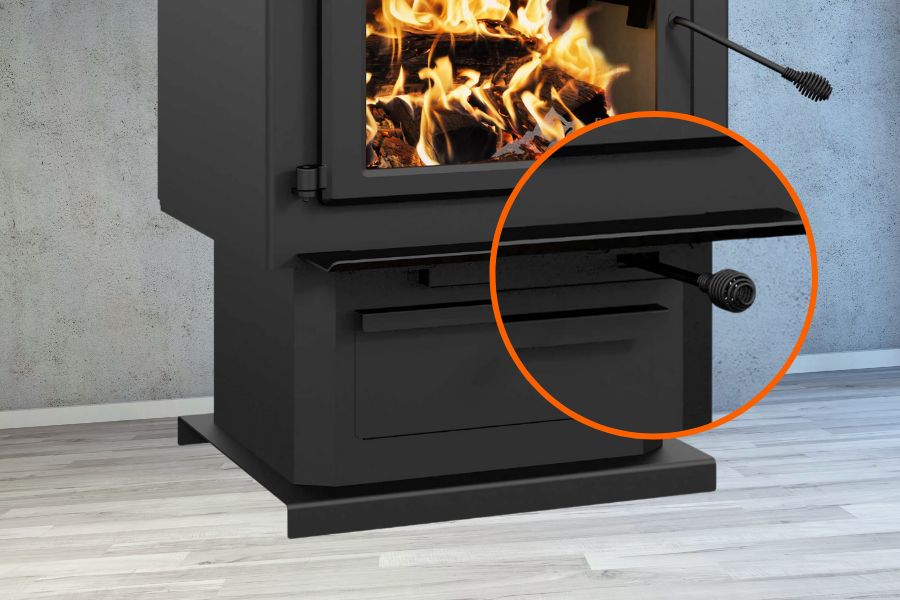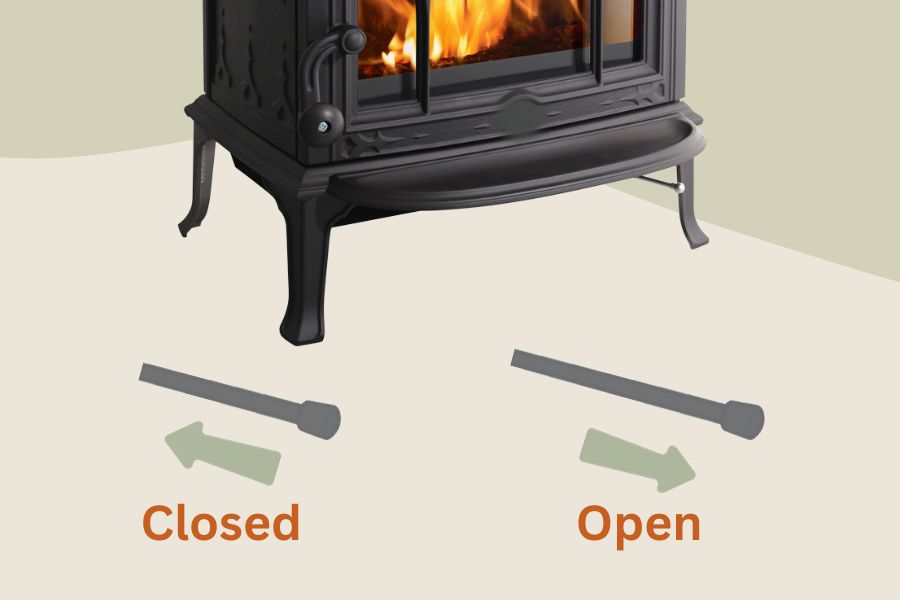Wood-burning stoves are a popular heat source and ambiance in many homes. They rely on the controlled burning of wood to generate heat and provide a cozy atmosphere.
However, proper ventilation is crucial to ensure that a wood burner operates efficiently and safely.
In this article, we’ll explore the role of cold air vents in wood burners and discuss whether they should be open or closed.
How Do Wood Burners Work?

Before diving into the role of primary air vents in wood-burning stoves, let’s briefly review how these appliances work.
A wood burner is a metal box with a stove door and a chimney that allows the gases produced by burning wood to escape.
Inside the box, there’s a firebox where you can load the logs and a grate that lets the ash and debris fall through.
Lighting a fire in the chimney firebox causes heat and smoke to rise and exit through the chimney. Cooler air from the front room enters through the air ducts to supply oxygen to the flames.
The Role of Air Vents in Regulating Combustion and Airflow
The air vent in a wood-burning stove serves several purposes. First, they control the amount of oxygen that reaches the fire, which in turn determines the rate of combustion and the heat output.
Opening the air ducts wider allows more air to enter open fireplaces, making the fire burn hotter and faster.
Closing the vents restricts the firewood’s air supply and slows the burning process. This reduces both the heat and the smoke output.
In addition to regulating the combustion, air vents also play a crucial role in managing the airflow inside the wood stove.
The natural convection of hot air rising and cool air sinking creates a constant flow of fresh air from the bottom and the top of the stove.
Adjusting the vents can control the airflow’s direction, temperature, and speed. This affects the stove’s temperature distribution and efficiency.
You can look closer at the various components of a fireplace and chimney and their function here.
Advantages of Keeping the Vents Open While Using a Wood Burner

Generally, experts recommend that you keep the vents open when using a wood-burning stove, particularly when starting a fire.
This allows the flames to catch and spread faster, reducing the amount of smoke and particulate matter released into the atmosphere.
Moreover, an open vent ensures that preheated primary air in the wood stove receives enough oxygen to burn the wood completely, which maximizes the heat output and minimizes the creosote buildup inside the chimney.
When to Close the Vents on a Wood Burner
However, once the fire is established and the wood is burning steadily, you can start adjusting the air vents to fine-tune the temperature and the airflow.
If you want the stove to produce more heat, you can open the vents wider to increase the oxygen supply and the combustion rate.
On the other hand, if you want to have additional air flow to reduce the heat output, you can close the vents gradually until you reach the desired level of airflow.
It’s also important to know when to close the vent completely, such as when you’re done using the stove or when you’re leaving the house.
Closing the vent prevents the chimney fires from consuming more wood and reduces the risk of accidental ignition or carbon monoxide poisoning.
However, don’t close the vents on log fire too early, as this can cause the wood to smolder and produce more smoke and harmful gases.
The Risks of Leaving the Vents Open or Closed for Too Long
Leaving the vents open or closed for too long can negatively affect the stove and the environment.
If you keep the vents open for too long, you can overheat the stove, damage the components, and waste energy.
Keeping the vents closed for too long can suffocate the fire, produce excessive smoke and creosote, and create a fire hazard. Be careful not to keep them closed for too long.
How to Adjust the Air Vents on a Wood-Burning Stove

Adjusting the air vents on a wood-burning stove is crucial for controlling combustion and maintaining an efficient burn.
Here are the steps to properly adjust the air vents on a wood-burning stove:
- Identify the Location of the Air Vents: The air vents are typically located at the bottom of the wood-burning stove. There may be one or two vents, depending on the model of the stove.
- Open the Vents: When starting a fire, it’s important to open the air vent fully to provide enough oxygen for the fire to ignite and start burning. This will help prevent the buildup of creosote in the chimney and ensure an efficient burn.
- Adjust the Vents as Needed: Adjust the air vent to control the combustion rate once the fire has started burning. Closing the vents slightly will reduce the available oxygen and slow down the burn rate. Opening the vents wider will increase the amount of oxygen available to the fire, which will increase the burn rate.
- Monitor the Temperature: It’s important to monitor the temperature of the stove while adjusting the air vent. A temperature gauge can be installed to help with this. Adjust the vents as needed to maintain a consistent temperature and avoid overheating or underheating the stove.
- Close the Vents: Close the air vent when only hot coals remain to prevent heat from escaping too quickly. This is important to remember. This will help maintain a steady temperature and extend the burn time of the wood.
Tips for Maintaining the Air Vents of a Wood Burner
- Clean the Air Vents Regularly: Air vents should be cleaned regularly to ensure that they are not blocked by debris or ash. Use a soft brush to remove any buildup, and make sure that the vents are clear.
- Check the Seals Around the Air Vents: Check the seals around the air vents to ensure they are tight and do not allow air to escape. Leaky seals can lead to inefficient combustion and decreased heat output.
- Monitor the Temperature of the Wood Burner: Monitoring the temperature of the wood burner is important to ensure that it’s not overheating or underheating. A temperature gauge can be installed to monitor the stove’s temperature and adjust the air vents accordingly.
- Use the Right Wood: Using the right type of wood is important for efficient and safe wood burning. Hardwoods like oak and maple burn hotter and longer than softwoods like pine and cedar. Avoid using wood that is wet or has been treated with chemicals.
- Schedule Professional Maintenance: It’s a good idea to have a professional inspect and maintain your wood stove at least once a year. They can ensure that the stove operates efficiently and safely and identify potential issues.
Conclusion
In conclusion, finding the right balance between air vents open and closed for efficient and safe wood burning is crucial.
Keeping the air supply open while using a wood burner stove has many benefits. It can improve combustion efficiency and reduce air pollution.
Close the air ducts once the wood burns have been fully combusted to prevent overheating and creosote buildup in the chimney.
Regular maintenance and proper use of wood-burning stoves can ensure their efficient and safe operation for many years.






